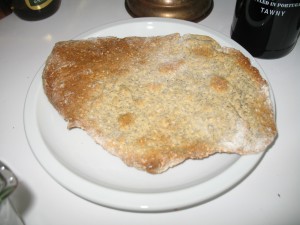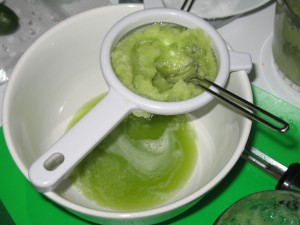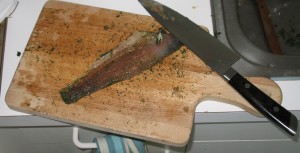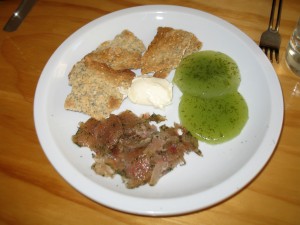Gravlax, cucumber jelly, and crackers
July 11, 2010
This recipe gave me the chance to do a few things: cure some fish, make jelly from scratch, bake crackers, and in the end assemble an impressive-looking dish relatively cheaply.
 [caption id="attachment_796" align="alignleft" width="300" caption="Cracker dough."][/caption]
[caption id="attachment_796" align="alignleft" width="300" caption="Cracker dough."][/caption]
 [caption id="attachment_797" align="alignleft" width="300" caption="A finished cracker."][/caption]
[caption id="attachment_797" align="alignleft" width="300" caption="A finished cracker."][/caption]
 [caption id="attachment_798" align="alignleft" width="300" caption="Straining out the cucumber juice."][/caption]
[caption id="attachment_798" align="alignleft" width="300" caption="Straining out the cucumber juice."][/caption]
 [caption id="attachment_799" align="alignleft" width="300" caption="A piece of cured trout, which I am about to slice into gravlax. Gravlax literally means "grave fish", as it was originally produced by burying salmon"][/caption]
[caption id="attachment_799" align="alignleft" width="300" caption="A piece of cured trout, which I am about to slice into gravlax. Gravlax literally means "grave fish", as it was originally produced by burying salmon"][/caption]
[ caption id="attachment_839" align="alignleft" width="300" caption="The completed dish, together with a little bit of creme fraiche."][/caption]
caption id="attachment_839" align="alignleft" width="300" caption="The completed dish, together with a little bit of creme fraiche."][/caption]
(Note: This is a followup to this post.)
I made the crackers a few days before the other components of the dish. Alton Brown’s recipe (which is what’s linked above) requires only 8 ingredients that are all combined together and then baked.
The result is a delicious, very hearty cracker with lots of poppyseeds and sesame seeds. These are also cheap to make, _if _you can get the seeds cheaply. I made I think 10 crackers at a cost of about $4, which beats grocery store prices, and that would come down if I had a cheaper source for the seeds.
The next day, I started on curing the fish. The recipe calls for arctic char as a substitute for salmon, but the char itself was unavailable, so I used trout (which is related). The trout is packed in lots of salt, some sugar, and dill, wrapped up tight, kept in the refrigerator for 2 days with a light weight on it, and flipped occasionally.
The salt draws out the moisture from the fish, making it inhospitable to microorganisms, and quite delicious to humans. In the picture, you’ll see a cured piece of trout after the process is over. An astroturf-like blanket of dill and salt has been scraped away. Even after it is unpacked, the fish will keep for a little while because of the salt that has been absorbed into it.
One note of caution is that the fish has to be wrapped carefully, as the liquid from the fish will almost certainly leak out otherwise.
Finally, the day before I was ready to serve I made the cucumber jelly. Jelly’s interesting because you can make it in almost any flavor, and so it opens up lots of culinary possibilities. In this case, I just had to puree some cucumber, strain it, then add gelatin. I put it in ramekins to set, and then when I was ready to serve, I warmed the ramekins up a little bit to get “pats” of cucumber jelly that could stand alone so that their bright green color showed through.
You have to be really careful with gelatin, as it melts easily. Fortunately, as I learned, if you accidentally melt too much of it you can set it back in the fridge to set again (though you can only do this once without adding more gelatin). Once it’s out, the trick is to handle it assertively as one piece. What I mean is, if you try to pick up one side of a pat of jelly, it will break. But if you can move the whole thing at once, by e.g. flipping it into your hand, you can slap it down with a reasonable amount of force without fear.